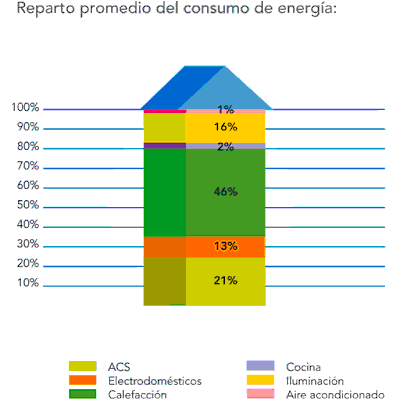It is essential, before carrying out an energy audit, to know the specific consumption of each particular use and, more specifically, what part of the total building consumption the different facilities represent. In this way, we can focus energy saving measures on the largest energy consumers, dedicating most of our efforts and investments to them.
In this post, we will address the energy consumption that occurs in residential buildings. Below, we include a graph showing the percentage of the total consumption represented by each facility.

From the image, the following conclusions can be drawn:
- The highest energy expenditure is, by far, the heating expenditure, accounting for 46% of the building’s total consumption. For this reason, energy audits should pay special attention to the heating system, temperature control, ventilation, and thermal envelope of the building.
- 67% of a home’s energy is used for direct heat generation (46% for heating and 21% for hot water). It is therefore essential to review the proper functioning of heat generators, such as boilers and heat pumps.
- Lighting accounts for 16% of the building’s total energy consumption, and more than half of the electricity expenditure. Using high-efficiency lamps, control mechanisms such as motion detectors, and proper use of natural light can lead to significant savings on the electricity bill.
- Appliances consume 13% of the total energy, and around one-third of the electricity used in homes. Among them, the biggest consumers are refrigerators, ceramic hobs, and washing machines. Conversely, the lowest consumption comes from computers, televisions, dishwashers, and microwaves. It is advisable to purchase high-efficiency appliances, especially the three mentioned above.
These values are a good indicator of the general case and serve as a starting point. However, it should be noted that they are indicative statistical values, obtained from the average of a large number of homes. Therefore, it is necessary for a specialized technician to analyze each building individually.
